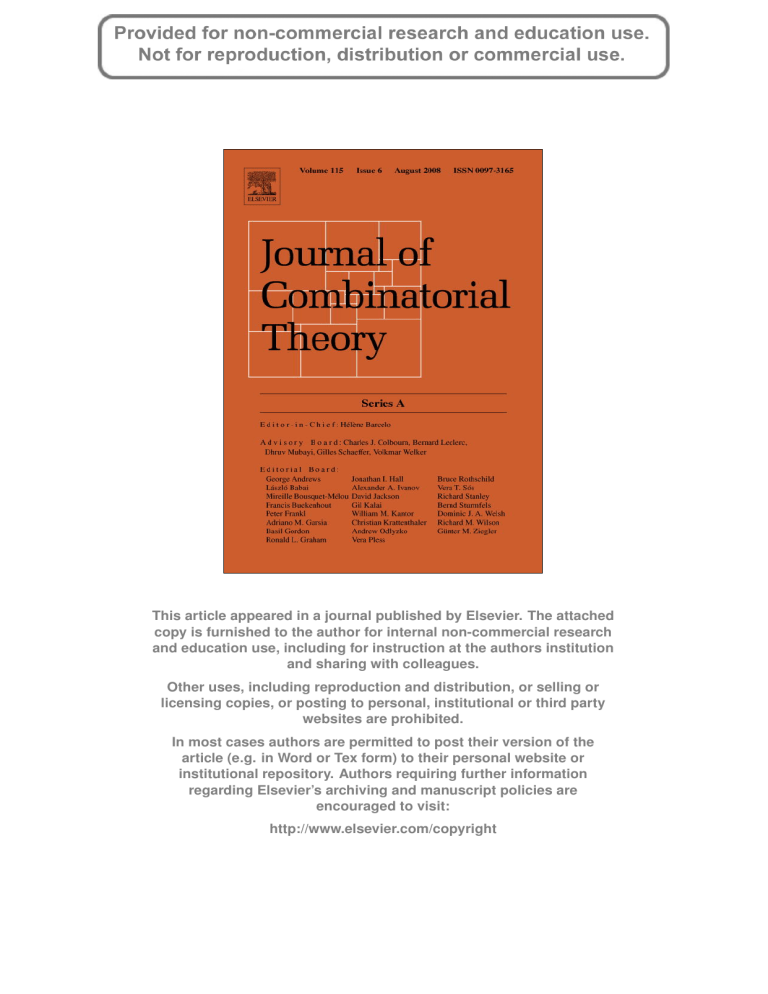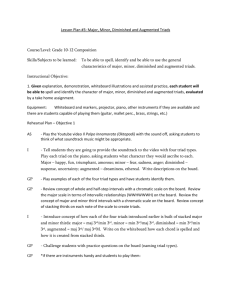This article appeared in a journal published by Elsevier. The... copy is furnished to the author for internal non-commercial research
advertisement

This article appeared in a journal published by Elsevier. The attached
copy is furnished to the author for internal non-commercial research
and education use, including for instruction at the authors institution
and sharing with colleagues.
Other uses, including reproduction and distribution, or selling or
licensing copies, or posting to personal, institutional or third party
websites are prohibited.
In most cases authors are permitted to post their version of the
article (e.g. in Word or Tex form) to their personal website or
institutional repository. Authors requiring further information
regarding Elsevier’s archiving and manuscript policies are
encouraged to visit:
http://www.elsevier.com/copyright
Author's personal copy
Journal of Combinatorial Theory, Series A 115 (2008) 1069–1076
www.elsevier.com/locate/jcta
Note
A major index for matchings and set partitions
William Y.C. Chen a,1 , Ira M. Gessel b , Catherine H. Yan a,c,2 ,
Arthur L.B. Yang a,1
a Center for Combinatorics, LPMC-TJKLC, Nankai University, Tianjin 300071, PR China
b Department of Mathematics, Brandeis University, Waltham, MA 02454-9110, USA
c Department of Mathematics, Texas A&M University, College Station, TX 77843, USA
Received 26 December 2006
Available online 26 December 2007
Abstract
We introduce a statistic pmaj(P ) for partitions of [n], and show that it is equidistributed with cr2 , the
number of 2-crossings, over all partitions of [n] with given sets of minimal block elements and maximal
block elements. This generalizes the classical result of equidistribution for the permutation statistics inv and
maj.
© 2007 Elsevier Inc. All rights reserved.
Keywords: Set partition; Matching; p-major index; 2-crossing
1. Introduction
One of the classical results on permutations is the equidistribution of the statistics inv and maj.
For a permutation π = (a1 a2 · · · an ), a pair (ai , aj ) is called an inversion if i < j and ai > aj .
The statistic inv(π) is defined as the number of inversions of π . The descent set D(π) is defined
as {i: ai > ai+1 }, and its cardinality is denoted des(π). The sum of the elements of D(π) is called
the major index of π (also called the greater index) and denoted maj(π). Similarly one can define
the notions of inversion, descent set, and major index for any word w = w1 w2 · · · wn of notE-mail addresses: chen@nankai.edu.cn (W.Y.C. Chen), gessel@brandeis.edu (I.M. Gessel), cyan@math.tamu.edu
(C.H. Yan), yang@nankai.edu.cn (A.L.B. Yang).
1 The first and the fourth authors were supported by the 973 Project on Mathematical Mechanization, the PCSIRT
Project of the Ministry of Education, the Ministry of Science and Technology, and the National Science Foundation of
China.
2 The third author was supported in part by NSF grant #DMS-0245526.
0097-3165/$ – see front matter © 2007 Elsevier Inc. All rights reserved.
doi:10.1016/j.jcta.2007.11.003
Author's personal copy
1070
W.Y.C. Chen et al. / Journal of Combinatorial Theory, Series A 115 (2008) 1069–1076
necessarily distinct integers. It is a result of MacMahon [7] that inv and maj are equidistributed
on any rearrangement class R(w). A statistic equidistributed with inv is called Mahonian.
There are many research articles devoted to Mahonian statistics and their generalizations. For
example, see [2,5] for Mahonian statistics for words, [10,11] for Mahonian statistics and Laguerre polynomials, [9] for a major index statistic for set partitions, and very recently [6] for
inv and maj for standard Young tableaux. Foata has given a nice bijective proof of the maj–inv
equidistribution result on permutations [3]. Given a partition of [n], there is a natural generalization of inversions, namely, 2-crossings, which can be viewed easily on a graphical representation
of the partition. In this paper we introduce a new statistic, called the p-major index and denoted
pmaj(P ), on the set of partitions of [n]. We prove that for any S, T ⊆ [n] with |S| = |T |, pmaj
and cr2 , the number of 2-crossings, are equally distributed on the set Pn (S, T ). Here Pn (S, T )
is the set of partitions of [n] for which S is the set of minimal block elements and T is the
set of maximal block elements. Restricted to permutations, the pair (cr2 , pmaj) coincides with
(inv, maj). Hence our result gives another generalization of MacMahon’s equidistribution theorem.
In the next section we list necessary notions and state the main results. The proofs and
some examples are given in Section 3. We prove the main result in two ways. The first one
uses generating functions, and the second one is a bijection derived from the algebraic argument.
2. Definitions and the main results
A partition of [n] = {1, 2, . . . , n} is a collection P of disjoint nonempty subsets of [n], whose
union is [n]. Each subset in P is called a block of P . A ( perfect) matching of [n] is a partition
of [n] in which each block contains exactly two elements. Denote by Πn the set of all partitions
of [n]. Following [1], we represent each partition P ∈ Πn by a graph GP on the vertex set [n]
whose edge set consists of arcs connecting the elements of each block in numerical order. Such
a graph is called the standard representation of the partition P . For example, the standard representation of 1457-26-3 has the arc set {(1, 4), (4, 5), (5, 7), (2, 6)}, see Fig. 1. We always write
an arc e as a pair (i, j ) with i < j , and say that i is the left-hand endpoint of e and j is the
right-hand endpoint of e.
A partition P ∈ Πn is a matching if and only if in GP , each vertex is the endpoint of exactly
one arc. In other words, each vertex is either a left-hand endpoint, or a right-hand endpoint.
In particular, a permutation π of [m] can be represented as a matching Mπ of [2m] with arcs
connecting m + 1 − π(i) and i + m for 1 i m. See Fig. 2 for example.
Two arcs (i1 , j1 ), (i2 , j2 ) of GP form a 2-crossing if i1 < i2 < j1 < j2 . Let cr2 (P ) denote
the number of 2-crossings of P . A 2-crossing is a natural generalization of an inversion of a
permutation. It is easily seen that under the correspondence π → Mπ , cr2 (Mπ ) = inv(π).
Given P ∈ Πn , define
min(P ) = {minimal block elements of P },
max(P ) = {maximal block elements of P }.
For example, for P = 1457-26-3, min(P ) = {1, 2, 3} and max(P ) = {3, 6, 7}.
Fix S, T ⊆ [n] with |S| = |T |. Let Pn (S, T ) be the set {P ∈ Πn : min(P ) = S, max(P ) = T }.
For any set X ⊆ [n], let X>i = X ∩ {i + 1, . . . , n}.
Author's personal copy
W.Y.C. Chen et al. / Journal of Combinatorial Theory, Series A 115 (2008) 1069–1076
1071
Fig. 1. The standard representation of partition P = 1457-26-3.
Fig. 2. The permutation π = 321 and the matching Mπ .
Fig. 3. The major index for partition 14-27-38-56 is 4.
Theorem 1. Fix S, T ⊆ [n] with |S| = |T |. Then
1 + y + · · · + y h(i)−1 ,
y cr2 (P ) =
i ∈T
/
P ∈Pn (S,T )
where h(i) = |T>i | − |S>i |.
nFor a permutation π = (a1 a2 · · · an ), the major index maj(π) can be computed as
i=1 des(ai · · · an ). This motivates the following definition of the p-major index for set partitions. Given P ∈ Πn , we start with the standard representation GP . First label the arcs of P
by 1, 2, . . . , k from right to left in order of their left-hand endpoints. That is, if the arcs are
(i1 , j1 ), (i2 , j2 ), . . . , (ik , jk ) with i1 > i2 > · · · > ik , then (ir , jr ) has label r, for 1 r k. Next
we associate a sequence σ (r) to each right-hand endpoint r. Assume that the right-hand endpoints are r1 > r2 > · · · > rk . (The set {r1 , . . . , rk } is exactly [n] \ S.) The sequence σ (ri ) is
defined backward recursively: let σ (r1 ) = a if r1 is the right-hand endpoint of the arc with label a. In general, after defining σ (ri ), assume that the left-hand endpoints of the arcs labeled
a1 , . . . , at are lying between ri+1 and ri . Then σ (ri+1 ) is obtained from σ (ri ) by deleting entries
a1 , . . . , at and adding b at the very beginning, where b is the label for the arc whose right-hand
endpoint is ri+1 . Finally, define the statistic pmaj(P ) by
des σ (ri ) .
pmaj(P ) :=
ri
Example 1. Let P = 14-27-38-56. Then (r1 , r2 , r3 , r4 ) = (8, 7, 6, 4). Fig. 3 shows how to
compute pmaj(P ). The sequences σ (ri ) are σ (8) = (2), σ (7) = (32), σ (6) = (132), and
σ (4) = (432). For each σ (ri ), the elements in the descent set are underlined. The p-major index of P is pmaj(P ) = 1 + 1 + 2 = 4.
Author's personal copy
1072
W.Y.C. Chen et al. / Journal of Combinatorial Theory, Series A 115 (2008) 1069–1076
Theorem 2. Fix S, T ⊆ [n] with |S| = |T |. Then
1 + y + · · · + y h(i)−1 ,
y pmaj(P ) =
P ∈Pn (S,T )
(1)
i ∈T
/
where h(i) = |T>i | − |S>i |.
Combining Theorems 1 and 2, we have
Corollary 3. For each Pn (S, T ),
y pmaj(P ) =
P ∈Pn (S,T )
y cr2 (P ) .
P ∈Pn (S,T )
That is, the two statistics cr2 and pmaj have the same distribution over each set Pn (S, T ).
When n = 2m, S = [m] and T = [2m] \ [m], the map π → Mπ gives a one-to-one correspondence between Pn (S, T ) and the set of permutations of [m]. It is easy to see that
pmaj(Mπ ) = maj(π). Hence the equidistribution of inv and maj for permutations is a special
case of Corollary 3.
Another consequence of Theorems 1 and 2 is the symmetry of the number of partitions of [n]
with a given number of 2-crossings (respectively a given p-major index). Let A(n, i; S, T ) be the
set of partitions in Pn (S, T ) such that cr2 (P ) = i, whose cardinality is a(n, i; S, T ).
Corollary 4. Fix n and let K =
metric. That is,
i ∈T
/ (h(i)
− 1). Then the sequence {a(n, i; S, T )}K
i=0 is sym-
a(n, i; S, T ) = a(n, K − i; S, T ).
The same result holds if we replace cr2 (P ) by pmaj(P ) in defining A(n, i; S, T ) and a(n, i; S, T ).
3. Proofs for the main results
In this section we give the proofs for Theorems 1 and 2. Given a partition P ∈ Πn , a vertex
i ∈ [n] in the standard representation GP is one of the following types:
1.
2.
3.
4.
a left-hand endpoint if i ∈ min(P ) \ max(P ),
a right-hand endpoint if i ∈ max(P ) \ min(P ),
an isolated point if i ∈ min(P ) ∩ max(P ),
a left-hand endpoint and a right-hand endpoint if i ∈
/ min(P ) ∪ max(P ).
In particular, [n] \ max(P ) is the set of points which are the left-hand endpoints of some arcs,
and [n] \ min(P ) is the set of right-hand endpoints. Fixing min(P ) = S and max(P ) = T is
equivalent to fixing the type of each vertex in [n]. Since the standard representation uniquely
determines the partition, we can identify a partition P ∈ Πn with the set of arcs of GP . Hence
the set Pn (S, T ) is in one-to-one correspondence with the set of matchings between [n] \ T and
[n] \ S such that i < j whenever i ∈ [n] \ T , j ∈ [n] \ S and i is matched to j . In the following
such a matching is referred as a good matching. Denote by Mn (S, T ) the set of good matchings
from [n] \ T to [n] \ S.
Author's personal copy
W.Y.C. Chen et al. / Journal of Combinatorial Theory, Series A 115 (2008) 1069–1076
1073
Fig. 4. cr2 (P ) for P ∈ P6 ({1, 2}, {5, 6}).
Proof of Theorem 1. Assume [n] \ T = {i1 , i2 , . . . , ik } with i1 < i2 < · · · < ik . Let S(H ) be
the set of sequences {(a1 , a2 , . . . , ak )} where 1 ar h(ir ) for each 1 r k. We give a
bijection between the sets Mn (S, T ) and S(H ). The construction is essentially due to M. de
Sainte-Catherine [8].
Given a sequence α = (a1 , a2 , . . . , ak ) in S(H ), we construct a matching from [n] \ T =
{i1 , i2 , . . . , ik } to [n] \ S as follows. First, there are exactly h(ik ) elements in [n] \ S which are
greater than ik . List them in increasing order as 1, 2, . . . , h(ik ). Match ik to the ak th element, and
mark this element as dead.
In general, after matching elements ij +1 , . . . , ik to some elements in [n] \ S, we process the
element ij . At this stage there are exactly h(ij ) many elements in [n] \ S which are greater than ij
and not dead. List them in increasing order by 1, 2, . . . , h(ij ). Match ij to the aj th of them, and
mark it as dead. Continuing the process until j = 1, we get a good matching M(α) ∈ Mn (S, T ).
The map f : α → M(α) gives the desired bijection between S(H ) and Mn (S, T ).
Let P (α) be the partition of [n] for which the arc set of GP is M(α). By the above construction,
the number of 2-crossings formed by arcs (ij , b) and (a, c) with a < ij < c < b is exactly aj − 1.
Hence cr2 (P (α)) = kj =1 (aj − 1) and
k
1 + y + · · · + y h(i)−1 .
2
(2)
y cr2 (P ) =
y j =1 (aj −1) =
P ∈Pn (S,T )
(a1 ,...,ak )∈S(H )
i ∈T
/
Example 2. Let n = 6, S = {1, 2}, and T = {5, 6}. Then [n] \ T = {1, 2, 3, 4}, [n] \ S =
{3, 4, 5, 6}, and h(1) = 1, h(2) = h(3) = h(4) = 2. Fig. 4 shows the correspondence between
S(H ) and Pn (S, T ). For simplicity we omit the vertex labeling.
To prove Theorem 2, we need a lemma on permutations.
Author's personal copy
1074
W.Y.C. Chen et al. / Journal of Combinatorial Theory, Series A 115 (2008) 1069–1076
Lemma 5. Let σ = a1 a2 · · · an−1 be a permutation of {2, 3, . . . , n}. Let σ0 = 1a1 · · · an−1 and for
i > 0 let σi be obtained from σ by inserting 1 right after ai . Then among the n permutations
σ0 , . . . , σn−1 , the major indices are all distinct and run from maj(σ ) to maj(σ ) + n − 1 in some
order.
Proof. First note that maj(σ0 ) = maj(σ ) + des(σ ). Assume that there are ti descents of σ that
are greater than i. Then
if ai > ai+1 ,
maj(σ ) + ti
maj(σi ) =
maj(σ ) + i + ti if ai < ai+1 or i = n − 1.
It can be checked that the major indices of σ0 , . . . , σn−1 are all distinct and run from maj(σ ) to
maj(σ ) + n − 1 in some order. 2
A similar version of the lemma, where one inserts n instead of 1, is used in [4] to get the
generating function of the major index over all permutations of [n],
y maj(π) =
π∈Sn
(1 − y)(1 − y 2 ) · · · (1 − y n )
.
(1 − y)n
(3)
This formula is the special case of Theorem 2 with S = [n] and T = [2n] \ [n].
Proofof Theorem 2. Consider the contribution of the arc with label 1 to the generating function P ∈Pn (S,T ) y pmaj(P ) . Again we identify the set Pn (S, T ) with the set Mn (S, T ) of good
matchings from [n] \ T to [n] \ S.
Let ik = max([n] \ T ), which is the left-hand endpoint of the arc labeled by 1 in the definition
of pmaj(P ), for any P ∈ Pn (S, T ). Assume T>ik = {j1 , j2 , . . . , jh(ik ) }. Let A = [n] \ (T ∪ {ik }),
and B = [n] \ (S ∪ {jh(ik ) }). For any good matching M between A and B let Mt (1 t h(ik )) be
the matching obtained from M by joining the pair (ik , jt ), and replacing each pair (a, jr ), r > t,
with (a, jr+1 ). Consequently, the arc labeling of Mt can be obtained from that of M by labeling
the arc (ik , jt ) by 1, and adding 1 to the label of each arc of M. Assume σ (j1 ) = b1 b2 · · · bh(ik )−1
for M. Then by the definition of pmaj, we have
− maj(b1 · · · bh(ik )−1 ),
1bt · · · bh(i
pmaj(Mt ) = pmaj(M) + maj b1 · · · bt−1
)−1
k
where bi = bi + 1. By Lemma 5, the values of
− maj(b1 · · · bh(ik )−1 )
1bt · · · bh(i
maj b1 · · · bt−1
k )−1
are all distinct and run over the set {0, 1, . . . , h(ik ) − 1}. Hence
y pmaj(P ) = 1 + y + · · · + y h(ik )−1
y pmaj(P ) .
P ∈Pn (S,T )
Eq. (1) follows by induction.
P ∈Pn−1 (A,B)
2
Example 3. The p-major indices for the partitions in Example 2 are given in Fig. 5. For simplicity
we omit the vertex labeling, but put the sequence σ (r) under each right-hand endpoint r.
The above algebraic proof can be easily translated into a bijection g from Mn (S, T ) to S(H ),
the set of integer sequences {(a1 , . . . , ak ): 1 ar h(ir ) for each 1 r k}, so that for all
Author's personal copy
W.Y.C. Chen et al. / Journal of Combinatorial Theory, Series A 115 (2008) 1069–1076
1075
Fig. 5. pmaj(P ) for P ∈ P6 ({1, 2}, {5, 6}).
M ∈ Mn (S, T ), if g(M) = (a1 , . . . , ak ), then pmaj(M) = kj =1 (aj − 1). Here we assume [n] \
T = {i1 , i2 , . . . , ik } with i1 < i2 < · · · < ik .
The map g : Mn (S, T ) → S(H ) is defined by induction on k, where k = |[n] \ T |, i.e., the
number of pairs in any matching of Mn (S, T ). For k = 1, there is only one matching M in
Mn (S, T ), and S(H ) = {(1)}. Let g(M) = (1). In general, assume that k 2 and M is a good
matching in Mn (S, T ). Let (ik , jk ) be the pair in M whose first entry ik is max([n] \ T ). Then
M1 = M \ {(ik , jk )} is a good matching with k − 1 pairs. By the inductive hypothesis, g(M1 )
is well-defined. Assume g(M1 ) = (a1 , . . . , ak−1 ). Set g(M) = (a1 , a2 , . . . , ak−1 , ak ) where ak =
pmaj(M) − pmaj(M1 ) + 1. By Lemma
5 and the proof of Theorem 2, g is a bijection from
Mn (S, T ) to S(H ), and pmaj(M) = kj =1 (aj − 1).
Theorem 6. There is a bijection ψ from Pn (S, T ) to itself such that pmaj(M) = cr2 (ψ(M)) for
each partition M ∈ Pn (S, T ).
Proof. Again identify Pn (S, T ) with the set Mn (S, T ) of good matchings. In the proof of
Theorem 1 we constructed a bijection f : S(H ) → Mn (S, T ) such that for any sequence
α = (a1 , . . . , ak ), cr2 (f (α)) = kj =1 (aj − 1). Composing the map g with f yields the desired
bijection. 2
Remark 1. The joint distribution of cr2 and pmaj is in general not symmetric over Pn (S, T ). For
example, let n = 8, S = {1, 2, 3, 5} and T = {4, 6, 7, 8}. Then
x cr2 (P ) y pmaj(P ) = x 5 y 5 + x 4 y 4 + 2x 3 y 4 + 2x 4 y 3 + x 3 y 3
P ∈P8 (S,T )
+ 3x 2 y 2 + 2xy + 1 + 2x 3 y 2 + x 2 y 3 + x 2 y + xy 3 .
Remark 2. We explain the combinatorial meaning of the quantities {h(i) = |T>i | − |S>i |: i ∈
/ T }.
The paper [1] gives a characterization of nonempty Pn (S, T )’s. Given a pair (S, T ) where S, T ⊆
[n] and |S| = |T |, associate to it a lattice path L(S, T ) with steps (1, 1), (1, −1) and (1, 0): start
from (0, 0), read the integers i from 1 to n one by one, and move two steps for each i.
Author's personal copy
1076
1.
2.
3.
4.
W.Y.C. Chen et al. / Journal of Combinatorial Theory, Series A 115 (2008) 1069–1076
If i ∈ S ∩ T , move (1, 0) twice.
If i ∈ S \ T , move (1, 0) and then (1, 1).
If i ∈ T \ S, move (1, −1) and then (1, 0).
If i ∈
/ S ∪ T , move (1, −1) and then (1, 1).
This defines a lattice path L(S, T ) from (0, 0) to (2n, 0). Conversely, the path uniquely determines (S, T ). Then Pn (S, T ) is nonempty if and only if the lattice path L(S, T ) is a Motzkin
path, i.e., never goes below the x-axis.
For each element i ∈ [n] \ T , there is a unique upper step (1, 1) in the lattice path L(S, T ).
We say an upper step is of height y if it goes from (x − 1, y − 1) to (x, y). Then the multiset
/ T } is exactly the same as the multiset {height of U : U is an upper step
{h(i) = |T>i | − |S>i |: i ∈
in L(S, T )}.
Acknowledgments
The authors thank the anonymous referees for helpful comments and suggestions.
References
[1] W.Y.C. Chen, E.Y.P. Deng, R.R.X. Du, R.P. Stanley, C.H. Yan, Crossings and nestings of matchings and partitions,
Trans. Amer. Math. Soc. 359 (2007) 1555–1575.
[2] B. Clarke, A note on some Mahonian statistics, Sém. Lothar. Combin. 53 (2005), Article B53a.
[3] D. Foata, On the Netto inversion number of a sequence, Proc. Amer. Math. Soc. 19 (1968) 236–240.
[4] H. Gupta, A new look at the permutation of the first n natural numbers, Indian J. Pure Appl. Math. 9 (6) (1978)
600–631.
[5] G.-N. Han, Une transformation fondamentale sur les réarrangements de mots, Adv. Math. 105 (1994) 26–41.
[6] J. Haglund, L. Stevens, An extension of the Foata map to standard Young tableaux, Sém. Lothar. Combin. 56 (2006),
Article B56c.
[7] P.A. MacMahon, Combinatory Analysis, vol. 1, Cambridge University Press, Cambridge, 1915, reprinted by
Chelsea, New York, 1955.
[8] M. de Sainte-Catherine, Couplages et Pfaffiens en combinatoire, physique et informatique, PhD thesis, University
of Bordeaux I, 1983.
[9] B. Sagan, A maj statistic for set partitions, European J. Combin. 12 (1991) 69–79.
[10] R. Simion, D. Stanton, Specializations of generalized Laguerre polynomials, SIAM J. Math. Anal. 25 (2) (1994)
712–719.
[11] R. Simion, D. Stanton, Octabasic Laguerre polynomials and permutation statistics, J. Comput. Appl. Math. 68 (1–2)
(1996) 297–329.







